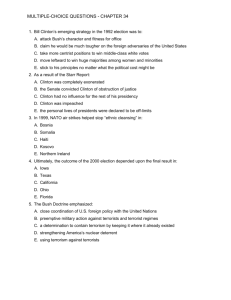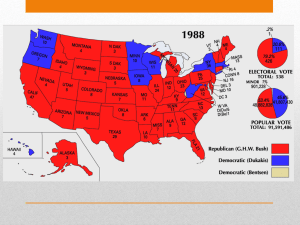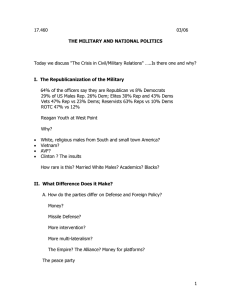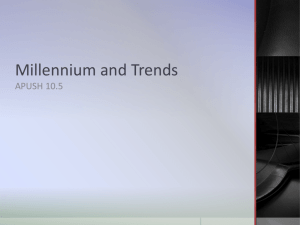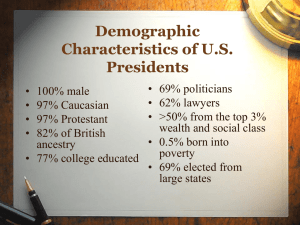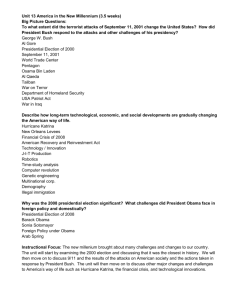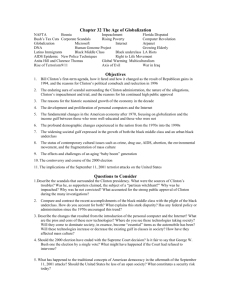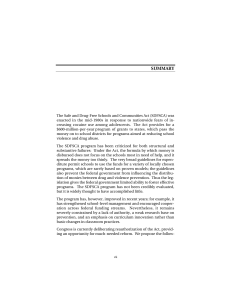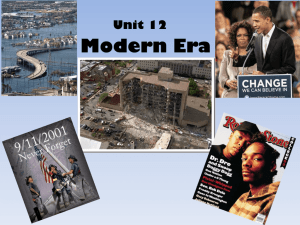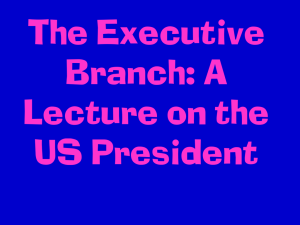Chapter 41 America Confronts the Post–Cold War Era, 1992–2011
advertisement
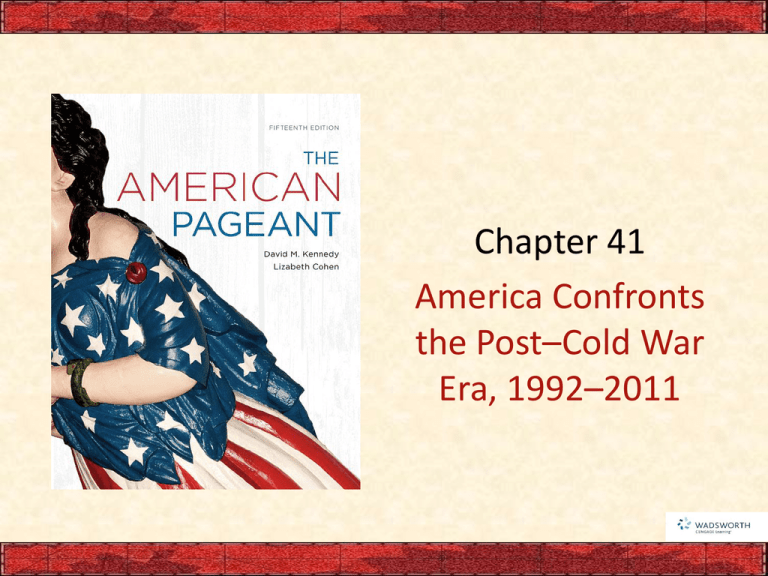
Chapter 41 America Confronts the Post–Cold War Era, 1992–2011 I. Bill Clinton: The First Baby-Boomer President • 1992 presidential race – Democrats: • Governor William Jefferson (“Bill”) Clinton for president • Senator Albert Gore for vice-president • Clinton claimed to be a “new” Democrat • Formed the Democratic Leadership Council: – Toward pro-growth, strong defense, and anticrime policies • Clinton campaigned vigorously on promises to stimulate the economy, reform the welfare system and overhaul the nation’s health-care apparatus. I. Bill Clinton: the First BabyBoomer President (cont.) – Republicans: – Wanted to continue the “social issues” of Reagan and Bush – Emphasized “family values” – Nominated George H. W. Bush and Vice President J. Danforth Quayle for a second term – Bush claimed credit for ending the Cold War and trumpeted his leadership in the Persian Gulf War – Election results: • 20% voted for H. Ross Perot—harped on the federal deficit • Only 55% of those eligible to vote went to the polls I. Bill Clinton: the First BabyBoomer President (cont.) • Clinton popular count 44,909,889; Bush 39,104,545; Perot 19,742,267 • Electoral count 370 Clinton; 168 Bush; 0 Perot • Clinton was the first baby boomer to ascend to the White House • Perot strongest showing for an independent or thirdparty candidate since Theodore Roosevelt 1912 (see Map 41.1) • Democrats won majorities in both houses • Near record of new members: 39 Africa Americans, 19 Hispanic Americans, 7 Asian Americans, one Native American, 48 women, 6 of them in the Senate • Nominated Ruth Bader Ginsburg to Supreme Court. p966 Map 41-1 p966 II. A False Start for Reform • Clinton though he had a mandate for reform – Gays and lesbians: • Advocating for an end to the ban of gays and lesbians in the armed services • Settled for a Don’t Ask, Don’t’ Tell” policy – That quietly accepted gay and lesbian soldiers and sailors without officially acknowledging their presence in the military (Congress finally repealed the discriminatory policy in 2010) – Health-care reform: • Appointed his wife, Hillary Rodham Clinton, as director of a task force charged with redesigning the medical service industry. II. A False Start for Reform (cont.) • Their stupefyingly complicated plan was dead on arrival when it was presented to Congress in October 1993 • Later she won election as a senator from New York in 2000 • The first First lady to hold public office—and later Secretary of State in the Obama administration – Deficit reduction bill 1993: • Combined with an increasingly buoyant economy by 1996 to shrink the federal deficit to its lowest level in more than a decade • Congress now arguing how to manage federal budget surpluses II. A False Start for Reform (cont.) – A sour antigovernment mood persisted: • Oklahoma City bombing of a federal building 1995 – 168 lives were lost – Was in retribution for a 1993 standoff in Waco, Texas, between federal agents and a fundamentalist sect known as Branch Davidians » Ended in the compound destroyed and the death of many women and children – Brought to light a lurid and secretive underground of paramilitary private “militias” armed and ultrasuspicious of all government. • Reflecting that pervasive disenchantment with politics and politicians, several states passed termlimit laws for elected officials. p967 III. The Politics of Distrust – Republicans offered voters a Contract with America • By Georgia Representative Newt Gingrich • Promised an all-out assault on budget deficit and radical reductions in welfare programs • Republicans won: 11 new governorships, 8 seats in the Senate, 53 seats in the House • Giving Republicans control of both houses for the first time in 40 years – Republicans overplayed their mandate for conservative retrenchment III. The Politics of Distrust (cont.) – In 1996 a major conservative victory was the Welfare Reform Bill: • Signed by a reluctant Clinton • Made deep cuts in welfare grants • Required able-bodied welfare recipients to find employment • Tightly restricted welfare benefits for legal and illegal immigrants – Reflecting a rising tide of anti-immigrant sentiment • Old-line liberal Democrats howled at the president’s betrayal of his party’s heritage III. The Politics of Distrust (cont.) • Clinton saw it as a shrewd political strategy of accommodating the electorate’s conservative mood • Contention between the Republican Congress and the Democratic president caused a showdown that forced the government to actually shut down for several days in 1993 • These events helped Clinton to rebound from his near-death experience – Election campaign of 1996: • Republican choose Robert Dole as their presidential candidate • Clinton was the Democratic candidate III. The Politics of Distrust (cont.) • Results: Clinton’s popular count 47,401,898 to Dole’s 39,198,482 (see Map 41.2) • Clinton won 379 electoral votes and Dole only 159 • Reform Party Ross Perot picked up less than half his votes of 1992 p968 IV. Clinton Again – Second term, Clinton only proposed only modest legislative goals • Warmly embraced the landmark Welfare Reform Bill of 1996 • Affirmative action: Clinton pledged to “mend it, not end it” – California passed Proposition 209 prohibiting affirmativeaction preferences in government, and higher education minority enrollments temporarily dropped – Federal court decision Hopwood v. Texas had the same effect – Clinton criticized these broad assaults but did not try to reverse them IV. Clinton Again (cont.) – Clinton’s major political advantage was the roaring economy • Sustained the longest period of growth supported by the Federal Reserve Board’s low interest rates and easy money • Unemployment rate crept down to 4% – Trade controversies • During his first term he supported the North American Free Trade Agreement (NAFTA): – Creating in 1993 a free-trade zone encompassing Mexico, Canada, and the United States – Bucked his own party protectionists IV. Clinton Again (cont.) • In 1994 he stepped toward a global free-trade system when he vigorously promoted the creation of the World Trade Organization (WTO): – The successor to the General Agreement on Tariffs and Trade (GATT) – Simmering discontent over trade policy boiled over in 1999 when he hosted the WTO meeting in Seattle – Protesters railed against the human and environmental cost of economic “globalization” p969 V. Problems Abroad – Clinton looked for a diplomatic formula to replace anticommunism as the basic premise of American diplomacy • After Somali rebels killed a dozen Americans, Clinton withdrew the U.S. units in March 1994 • Burned by Somalia, Washington only stood by in 1994 when catastrophic ethnic violence in Rwanda resulted in the death of half a million people – Clinton struggled to define a policy with China • Which was rapidly emerging as an economic and political powerhouse V. Problems Abroad (cont.) • Soft-pedaled on Beijing regime on human rights • Began seeking improved trade relations • By 2000 he was crusading for a controversial China trade bill • Congress passed it in May 2000: – Making the Asian giant a full-fledged trading partner of the United States – Tormented Balkans in southeastern Europe • Ethnic conflict raged through Bosnia—Washington did nothing • Finally they decided to commit American troops to a NATO peacekeeping contingent in 1995 V. Problems Abroad (cont.) • NATO’s continuing presence in Bosnia failed to pacify the Balkans completely • Serbian president Slobodan Milosevic in 1999 unleashed a new round of “ethnic cleansing” in the region, this time against ethnic Albanians in the province of Kosovo – U.S.-led NATO forces launched an air war against Serbia – The bombing campaign eventually forced Milosevic to accept a NATO peacekeeping force on ground in Kosovo – Milosevic was arrested in 2001 and put on trial before the International Criminal Court in the Hague, where he died in 2006 before the trial was completed. V. Problems Abroad (cont.) • Middle East a major focus of American diplomacy right through Clinton’s tenure: – In 1993 Clinton presided over a historic meeting at the White House between Israeli premier Yitzhak Rabin and Palestine Liberation Organization (PLO) leader Yasir Arafat » They agreed in principle of self-rule for the Palestinians within Israel » Two years later Rabin fell to an assassin’s bullet » Clinton and his second-term Secretary of State Madeleine Albright spent the rest of the 1990s trying to find a solution to the Israeli Palestinian problem • Finally Clinton stepped in to leave a legacy as an international peacemaker V. Problems Abroad (cont.) – Along with his work in the Middle East – He sought to bring peace to Northern Ireland and the Korean peninsula – He traveled to India and Pakistan in hopes of reducing rivalry between two nuclear powers of southern Asia • But the guiding principles of American foreign policy in the post-Cold War era remained ill-defined and elusive. VI. Scandal and Impeachment • Scandal had dogged Bill Clinton from the beginning of his presidency – Critics brought charges of everything from philandering to illegal financial transactions: • Allegations of corruption from a real estate deal called Whitewater while he was governor of Arkansas triggered an investigation by a special prosecutor, but no indictment ever materialized. – The Lewinsky affair: • In January 1998 Clinton engaged in a sexual affair with a young White House intern, Monica Lewinsky VI. Scandal and Impeachment (cont.) • Lied under oath about this affair, and was accused of another sexual harassment case • In September 1998 the special prosecutor investigating Whitewater brought a report to the House of Representatives • The report presented 11 possible grounds for impeachment, all related to lying about Lewinsky • The House cranked up the machinery of impeachment • In December 1998 the House passed two articles of impeachment against the president: – Perjury before a grand jury – Obstruction of justice. VI. Scandal and Impeachment (cont.) – Democrat minority charged that: • However deplorable Clinton’s personal misconduct, sexual transgressions did not rise to the level of “high crimes and misdemeanors” prescribed in the Constitution (see Art. II, Sec. IV in the Appendix) • House Republican managers (prosecutors) of impeachment for the Senate trial replied that perjury and obstruction were grave public issues and that nothing less than the “rule of law” was at stake – Most Americans leaned toward the view of his actions as low follies VI. Scandal and Impeachment (cont.) • 1998 midterm elections voters reduced the House Republicans’ majority – Causing Gingrich to resign his post • President Clinton: – Most held a low opinion of his personal morals » But liked most of his political and economic polices » Wanted him to stay in office – In early 1999 for the first time in 130 years, the nation witnessed an impeachment proceeding in the U.S. Senate » Facts widely known » The two parties’ political positions firmly locked in VI. Scandal and Impeachment (cont.) • Results of the trial: – Obstruction of justice—5 northeastern Republicans joined all 45 Democratic senators in voting not guilty – The 55 votes for conviction fell far short of the constitutionally required two-third majority – The vote on perjury charge was 45 guilty, 55 not guilty. p970 p971 VII. Clinton’s Legacy and the 2000 Election – Clinton’s legacy was mixed: • His sound economic policies encouraged growth and trade in a rapidly globalizing post-Cold War world • As a “New Democrat” and avowed centrist, he did more to consolidate than to reverse the Reagan-Bush revolution against the New Deal liberalism • Setting such a low standard in his personal conduct, he replenished the sad reservoir of public cynicism about politics • At the end of his term, Democrats stayed on their political course and nominated Albert Gore for president. VII. Clinton’s Legacy and the 2000 Election (cont.) – Albert Gore • Chose as his vice-presidential candidate Senator Joseph Lieberman, an outspoken critic of Clinton • Lieberman was first Jewish person nominated to a major national ticket • Their Republican challenger was George W. Bush: – Surrounded himself with Washington insiders – Including vice-presidential nominee Richard Cheney – As a clear jab at Clinton, promised to “restore dignity to the White House” • Rosy estimates that the federal budget would produce a surplus of $2 billion in the coming decade set the stage for the presidential contest. VII. Clinton’s Legacy and the 2000 Election (cont.) – Candidates’ economic views • Bush: – Returning the budget surplus to “the people” – Through massive tax cuts – And promoting private sector programs, such as school vouchers and a reliance on “faith-based” institutions to help the poor. • Gore: – Proposed small tax cuts – Targeted at middle and lower class people – Strengthening Social Security. • Foreign policy hardly figured in the campaign VII. Clinton’s Legacy and the 2000 Election (cont.) • Election results: • Pollsters predicted a close election • Election day the country nearly split evenly between the two candidates • Florida’s electoral votes would determine the winner • A five-week political standoff over how to count the votes in Florida – Democrats argued that some ballots were confusing or had been misread by machines and asked for recounts by hand in several countries – Republicans claimed that such recounts would amount to “changing the rules in the middle of the game” and thus thwart the rule of law. VII. Clinton’s Legacy and the 2000 Election (cont.) • After weeks of legal bickering, the Supreme Court intervened: – By a five-to-four vote along partisan lines – The Court reasoned that since neither Florida’s legislature nor its courts had established a uniform standard for evaluating disputed ballots, the hand counts amounted to an unconstitutional breach of the Fourteenth Amendment’s equal protection clause. – The ruling gave Bush the White House but cast a dark shadow of illegitimacy over his presidency – Bush officially won Florida by 537 votes out of 6 million cast VII. Clinton’s Legacy and the 2000 Election (cont.) • Election results: • Bush electoral count 271 to 266 for Gore (see Maps 41.3 and 41.4) • National popular vote went decisively to Gore: Gore: 50,999,897 to 50,456,002 for Bush • For the first time since 1888, a candidate won the White House with fewer popular votes than his opponent • Calls to abolish the Electoral College, however, were few and muted (see Art. V of the Constitution) p972 VIII. Bush Begins • Bush: – Son of the forty-first president (“41”), George W. Bush was “43” – Became the first presidential offspring since John Quincy Adams to reach the White House – He promised • To bring to Washington the conciliatory skills he had honed as the Republican governor of Texas • Where he worked well with the Democratic majority in the state’s legislature. VIII. Bush Begins (cont.) – Bush as president: • Soon proved to be a divider rather than a uniter • Less a “compassionate conservative” than a crusading ideologue • He withdrew American support from international health programs that sanctioned abortion: – Religious traditionalists cheered – Liberals jeered • Advocated federally financed faith-based socialwelfare initiatives • Sharply limited government-sponsored research on embryonic stem cells VIII. Bush Begins (cont.) • Pleased corporate chieftains but angered environmentalists by challenging scientific findings on ground-water contamination and global warming • Repudiated the Kyoto Treaty limiting greenhouse gas emissions (negotiated by the Clinton administration but never ratified by the Senate) • Advocated new oil exploration in the Arctic National Wildlife Refuge on Alaska’s ecologically fragile north coast • Allowed Vice President Cheney to hammer out his administration’s energy policy in behind-closed-doors meetings with representatives of several giant oil companies VIII. Bush Begins (cont.) • He pressed ahead with a whopping $1.3 trillion tax cut. • With the softening of the economy and the increasing costs of the war in Iraq, the tax cut turned the federal budget surpluses of the late 1990s into yawning deficits, reaching more than $400 billion in 2004 (see Figure 41.1) Map 41-4 p973 Figure 41-1 p974 IX. Terrorism Comes to America – On September 11, 2001, the long era of America’s impregnable national security violently ended • Suicidal terrorists slammed two hijacked airliners, loaded with passengers and jet fuel, into the twin towers of New York City’s World Trade Center • They flew a third plane into the military nerve center of the Pentagon, near Washington, D.C., killing 189 • Heroic passengers forced a fourth hijacked aircraft to crash in rural Pennsylvania, killing all 44 aboard IX. Terrorism Comes to America (cont.) • As the two skyscrapers collapsed, some 3,000 innocent victims perished • The face of the catastrophic terrorism of 9/11 • Bush responded to the Congress nine days later: – He emphasized his respect for the Islamic religion and Muslim people – He identified the principal enemy as Osama bin Laden, head of a shadowy terrorist network known as Al Qaeda (“the base” in Arabic) » Wealthy extremist exiled from his native Saudi Arabia » Associated with attacks on American embassies in East Africa and on the USS Cole in Yemen » Taken refuge in landlocked Afghanistan, ruled by Islamic fundamentalists called the Taliban IX. Terrorism Comes to America (cont.) » Bin Laden harbored venomous resentment toward the United States for its growing military presence in the Middle East » And because of its unyielding support for Israel in the face of intensifying Palestinian nationalism » He fed on worldwide resentment of America’s enormous economic, military and cultural power – When the Taliban refused to turn over Bin Laden, Bush ordered a massive military campaign against Afghanistan – Within three months American and Afghan rebel forces had overthrown the Taliban • Congress in October 2001 passed the USA Patriot Act – The act permitted extensive telephone and e-mail surveillance and authorized the detention of immigrants suspected of terrorism. IX. Terrorism Comes to America (cont.) – In 2002 Congress created the new cabinet Department of Homeland Security: • To protect the nation’s borders • Ferret out potential attackers – The Justice Department: • Rounded up hundreds of immigrants and held them without habeas corpus (formal charges in an open court) • Bush called for trying suspected terrorists before military tribunals, where the usual rules of evidence and procedure did not apply. IX. Terrorism Comes to America (cont.) – Guantanamo Detention Camp: • Located on the American military base at Guantanamo, Cuba • Place where hundreds of Taliban fighters from Afghanistan languished in legal limbo and demoralizing isolation. • Catastrophic terrorism posed an unprecedented challenge to the United States – Americans once enjoyed virtually cost-free national security that undergirded the values of openness and individual freedom that defined the distinctive character of American society – Now American security and American liberty alike were dangerously imperiled. p974 p975 p976 X. Bush Takes the Offensive Against Iraq • Bush warned that the United States would not tolerate Iraq’s defiance of UN weapons inspections • Saddam Hussein expelled the inspectors from Iraq in 1998 • President Clinton had declared that Saddam’s removal (“regime change”) was an official goal of U.S. Policy • The Bush administration focused on Iraq with a vengeance • He claimed that Iraq, Iran, and North Korea constituted an “axis of evil” that gravely menaced American security X. Bush Takes the Offensive Against Iraq (cont.) • Saddam Hussein became the principal object of Bush’s wrath • Bush was willing to wage a preemptive war with Iraq • Bush began laying plans for a war • He accused Hussein and the Iraqi regime of all manner of wrongdoing: – Oppressing its own people – Frustrating the weapons inspectors – Developing nuclear, chemical, and biological weapons of mass destruction (“WMD”) – Supporting terrorist organizations – Suggested that a liberated, democratized Iraq might » Provide a beacon of hope to the Islamic world » Begin to improve the political situation in Middle East. X. Bush Takes the Offensive Against Iraq (cont.) • Secretary of State Colin Powell was more cautious • Congress passed a resolution authorizing the president to employ armed forces to defend against Iraqi threats to Americans’ security – To enforce United Nations resolutions regarding Iraq. • United Nations voted to give Iraq “a final opportunity to comply with its disarmament obligations.” • On March 19, 2003, Bush, with only Britain, launched the long-anticipated invasion of Iraq • Less than a month later, Baghdad had fallen and Saddam was driven from power, hounded into hiding X. Bush Takes the Offensive Against Iraq (cont.) • Saddam was found and arrested nine months later and executed in 2006. • Bush on an U.S. aircraft carrier spoke under a banner declaring “Mission Accomplished.” • Bush announced on May 1, 2003, that “major combat operations in Iraq have ended” (see Map 41.5) Map 41-5 p977 p977 XI. Owning Iraq – Post-Saddam Iraq devolved into a seething cauldron of violence • Sunni and Shia Muslims clashed violently, especially in Baghdad • Both groups attacked American forces – Especially after the U.S. decision to disband the Iraqi army • Local insurgency spread and occupied Iraq which was even more perilous for American troops • Hatred for Americans only worsened: – With the revelations in April 2004 of Iraqi prisoners tortured and humiliated at the Abu Ghraib prison. XI. Owning Iraq – Al Qaeda moved in afterward – Three battles: • Shia-Sunni ethnic violence • Counter-occupation insurgency • Jihadist terrorism: » Fed a spiraling maelstrom of bloodshed » By the end of 2006, more Americans had died in Iraq than in the attack of September 11 (see pp: 980-981) – Almost from the outset of the intervention, American forces began preparing to withdraw XI. Owning Iraq • The American military ceded political power and limited sovereignty to an interim Iraqi government • National elections followed in early 2005 • Millions of Iraqis voted for a national assembly to draft a constitution • Followed by a referendum vote on the constitution in October 2005 • Elections for choosing parliamentary representatives, a president, and prime minister • Under Iraq’s new democratic government were deep violent tensions. p978 XII. Reelecting George W. Bush • Divided twenty-first century America: – Civil libertarians concerned about government trampling on personal freedom – Corporate fraud fed rampant popular disillusion with the business community – Cultural tensions over the rights of gays and lesbians – Affirmative action sparked sharp debate when the Supreme Court permitted preferential treatment in admitting minority undergraduate and law students-University of Michigan, 2003. XII. Reelecting George W. Bush (cont.) • Bush positioned himself for running for a second term: – Proclaimed tax cuts had spurred economic growth – Championed the No Child Left Behind Act (2002) • Mandated sanctions against schools that failed to meet federal performance standards – Played to cultural conservatives: • In opposing stem cell research • Called for a constitutional amendment to ban gay marriage XII. Reelecting George W. Bush (cont.) – He promoted himself as a stalwart leader in wartime • Democrats: – Chose John Kerry to represent their ticket – He pushed progressive visions of government – Counted on his Vietnam War record • Election results: – – Bush received the first popular vote majority by a presidential candidate in more than a decade—60,639,281 to 57,355,978—and won the Electoral College, 286 to 252. This time his victory was clear, constitutional and uncontested. XIII. Bush’s Second Term • Bush had “political capital” to spend on an aggressive domestic agenda – Appointment of two conservative Supreme Court justices: John G. Roberts, Samuel A. Alito – He proposed a radical program to privatize much of Social Security • Opposed by the AARP and other liberal groups • Idea faded away within six months of his reelection • Same fate for a constitutional amendment to ban same-sex marriage – Was a major “values” issue in the 2004 campaign XIII. Bush’s Second Term (cont.) – Compromise plan for immigration reform: • To establish a guest-worker program; • A “path to citizenship” for the undocumented, ended up pleasing no one • Rejected by Congress in the summer of 2007 – Issue dead for the rest of the Bush’s term (see p. 1000). – Scandals: • Political not personal: – Vice President Cheney convicted of perjury in an investigation into the source of a leak that exposed the identity of an undercover CIA agent as political retaliation against her antiwar husband. XIII. Bush’s Second Term (cont.) • In December 2005 journalists discovered that the government was conducting illegal wiretap surveillance – On American citizens inside the United States – In violation of federal law • Hurricane Katrina: (late August 2005) – – – – Which devastated New Orleans and much of the Gulf Coast Flooding 80% of the historic city Causing 1,300 deaths and $150 billion in damages The Federal Emergency Management Agency (FEMA) proved pathetically inept in New Orleans, and Bush came in for more criticism. p980 Table 41-1 p981 p982 XIV. Midterm Elections of 2006 – Charges of dictatorial power-grabbing, cronyism, and incompetence mounted in Bush’s 2nd term: • Republicans fell victim • Democrats narrowly regained control of both houses of Congress: – For the first time since they had lost them to the Gingrich revolution of 1994 (see p. 968) – California Democrat Nancy Pelosi became the first woman to serve as Speaker of the House. • Biggest factor in them winning was the perceived mishandling of the war in Iraq – Pre-war claims about WMD and Iraq’s connections to Al Qaeda and 9/11 had all proved false XIV. Midterm Elections of 2006 (cont.) – The Defense Department under Secretary Donald Rumsfeld: » Had badly mismanaged events on the ground » He resigned after the Republicans’ “thumping” in 2006 midterm elections • Iraq: – Iraq still no peace – Death toll, Iraqi and American alike, continued to rise – Bush administration attempted to gain greater control in early 2007 with a “surge” of 20,000 additional troops – The surge brought a modest measure of stability to Iraq – As the 2008 election cycle got under way, public opinion solidified against the war • President Bush’s approval ratings sank below 30%. p982 XV. The Presidential Election of 2008 • 2008 election was truly “open” for the first time in 80 years: – Democratic race: • Fiercely fought contest between 46 year old, 1st term Illinois Senator Barack Obama and former First Lady and sitting New York senator Hillary Rodham Clinton – Obama narrowly prevailed, surviving Clinton’s attacks on his experience – He promised voters a “postpartisan” politics – To strengthen his national security credentials, he picked foreign-policy-savvy Delaware senator Joseph Biden as his running mate. XV. The Presidential Election of 2008 (cont.) – Republicans nominated Arizona senator John McCain: • Self-styled “maverick” and a Vietnam War hero • Had a record of supporting bipartisan legislation • Picked Sarah Palin as his running mate – She galvanized the conservative Republican base. – Obama: • With $700 million, raised from small donors via the internet: – He seized the advantage in both the “air war” (television) – And the “ground war” (door-to-door campaigning) XV. The Presidential Election of 2008 (cont.) – His television debates favorably impressed many voters – His campaign slogan, “Yes we can,” excited widespread hope and enthusiasm – A sudden economic maelstrom gave his campaign a buoyant boost. – The American housing price bubble: • Feb by years of the Federal Reserve System’s easymoney policies • The private banking system’s lax lending practices burst at last • Long era of cheap and abundant credit was abruptly ended XV. The Presidential Election of 2008 (cont.) • 2008 collapse in real estate values generated a tsunami of mortgage defaults: – Especially “subprime” borrowers • Aggressive “deleveraging”—selling assets at everdeclining prices • Some debts could not be unloaded at any price, and credit markets soon froze everywhere – Wall Street firm of Lehman Brothers collapsed in September 2008, resulting in stocks falling into a deep swoon – The gravest financial hurricane since the Great Depression of the 1930s was gathering ever-increasing force (see Figure 41.2) XV. The Presidential Election of 2008 (cont.) – Bush administration actions: • Federal government nationalized the country’s two biggest mortgage companies: – Federal National Mortgage Association (“Fannie Mae”) – Federal Home Mortgage Corporation (“Freddie Mac”) • And took over the world’s biggest insurance company – The American International Group (AIG) • Treasury secretary Henry Paulson persuaded Congress to create the Trouble Assets Relief Program (TARP): – Authorizing a whopping $700 billion to buy “toxic” assets – Inject cash directly into the nation’s biggest banks and corporations. XV. The Presidential Election of 2008 (cont.) – Candidate Obama: • Called for reviving the faltering economy with bold public investments in alternative energy and infrastructure repair • Voters delivered a historic victory to Barack Obama – Election results: • Obama garnered 53% of the popular vote, prevailing in traditional Republican strongholds such as Virginia, Nevada, and Colorado • Won the Electoral College 365 to 173 (see Map 41.6) • Democrats enlarged their majorities in the House and the Senate. XV. The Presidential Election of 2008 (cont.) – Obama’s election: • Opened a new chapter in the long-vexed history of American race relations • Confronted the nation’s first African American president with the daunting challenge of: – Governing a country in two wars – As it sank into the deepest economic abyss since the 1930s. p983 Figure 41-2 p984 41-6 p985 XVI. Obama in the White House – Even as Obama was giving his inaugural address: • • • • Home construction was grinding to a halt Mortgage foreclosures were soaring Countless businesses were shutting their doors The economy was shedding a sickening 700,000 jobs a month • Employment rate climbed to above 10%--the highest level since the early 1980s – Heralding a return to the catastrophic joblessness of the Great Depression of the 1930s. XVI. Obama in the White House (cont.) – Obama’s major initiatives to help troubled banks, tax and mortgage relief • A huge “stimulus” bill—the American Relief and Recovery Act: – Contained nearly a trillion dollars of tax cuts – New spending for jobs, infrastructure projects, relief to state and local governments – Shored up bankrupt automakers General Motors and Chrysler – As well as threatened banks and insurance companies. • The nonpartisan Congressional Budget Office estimated it saved up to 3 million jobs XVI. Obama in the White House (cont.) – Hope for a rapid recovery proved false, and the first steps toward growth were feeble and faltering: • • • • • The unemployment rate stayed above 9% Millions of Americans lost their jobs and homes Many more succumbed to anxiety and fear Anxious consumers cut back on spending Burdening an already sluggish recovery. – Obama sought the long-sought liberal goal of heath care reform XVI. Obama in the White House (cont.) – The Patient Protection and Affordable Care Act: • March 2010, new health-care law (derided by critics as “Obamacare”) • Mandated all Americans to purchase health insurance starting in 2014 • Required states to establish “exchanges” whereby individuals and small businesses could purchase health-care insurance at competitive rates • Prohibited insurers from denying coverage to anyone with a preexisting medical condition • Allowed children up to 21 to remain covered by their parent’s health plan. XVI. Obama in the White House (cont.) • The price of the bill was estimated at $940 billion over ten years • Experts predicted the bill’s cost-cutting measure would reduce the federal deficit by more than $1 trillion over twenty years – The 2010 Wall Street Reform and Consumer Protection Act: • A major overhaul of the nation’s financial regulatory system • Aimed to curb the risky, high-flying practices that had contributed to the debacle of 2008: – Controls on banks, investment houses, and stock markets, and new truth-in-lending rules to protect consumers. XVII. A Sea of Troubles – Obama had trouble reaping the political rewards of these legislative achievements because: • His measures only halted, but did not reverse, the economy’s decline • Federal budget deficits ballooned dramatically on his watch • A deep vein of American wariness of “big government” • Attacks on the health care reform, accusing him of promoting “socialism” • And “unconstitutional” control over individual lives. XVII. A Sea of Troubles (cont.) – The “Tea Party” • Rose to challenge the president and his policies • A grassroots movement of populism – Republicans determined to fight the administration. – President’s successes and failures: • Appointment of two new Supreme Court Justices: – – – – – Sonia Sotomayor, first Hispanic, in 2009 Elena Kagan in 2010 A “cap-and-trade” bill failed His approval ratings steadily slipped His party slid downhill with him XVI. A Sea of Troubles (cont.) – Midterm elections of 2010; Republicans gained six seats in the Senate and 63 in the House • Other accomplishments: – In December 2010, an $858 billion package that extended unemployment benefits – As well as the Bush-era tax cuts – The repeal of “Don’t Ask Don’t Tell” – A renewed nuclear arms reduction treaty (New START, or Strategic Arms Reduction Treaty) with Russia – Failed passing the DREAM Act (Development, Relief, and Education of Alien Minors Act) – The vexed issues of immigration reform, with respect to the nation’s 12 million “illegals,” also waited for resolution another day. XVIII. Wars, Oil Spills, and Political Backlash – Obama inherited America’s wars in Iraq and Afghanistan, as well as other headaches: • Sought to wind down the Iraq war, meeting a deadline of the summer 2010 • Still 50,000 troops remained in the country to protect U.S. bases and support Iraqi security efforts • He declared the Afghan war was necessary to defeat Al Qaeda and prevent future terrorism – Afghan jihadi (militant Islamic) fighters grew stronger against an Afghan government plagued by incompetence and corruption – The Taliban and Al Qaeda found refuge across the border in unstable but nuclear-armed Pakistan XVIII. Wars, Oil Spills, and Political Backlash (cont.) – In December 2009 he declared that American troops would begin withdrawing by 2011: » In order to achieve that goal he was deploying an additional 30,000 troops to combat the insurgency » He ordered changes in strategy and appointed a new U.S. Commander, General David Petraeus – Obama faced an unprecedented environmental calamity: • April 20, 2010, the BP (formerly British Petroleum) energy corporation’s Deepwater Horizon oil platform in the Gulf of Mexico exploded: – Killing 17 workers – Spewing oil from its deep well nearly two miles below the ocean floor. XVIII. Wars, Oil Spills, and Political Backlash (cont.) • By the time the well was finally capped in August 2010, it had become the worst oil disaster in U.S. history – American forces concluded a ten-year manhunt and killed Osama bin Laden in May 2011 • The president’s poll ratings got a brief upward bump – The lift proved vanishingly brief • The accumulated federal debt approached its legal limit of $14.3 trillion in the summer of 2011 – Appeal to raise the debt ceiling was refused by the 85 newly elected freshmen in 2010. XVIII. Wars, Oil Spills, and Political Backlash (cont.) – Republicans were looking to the upcoming 2012 presidential election with increasing hope for victory: • Some critics began to question the soundness of the American political system itself • Dramatic demographic changes were altering the political landscape, with consequences that both parties struggled to understand (see Map 41.7) p987 41-7 p988 p989
